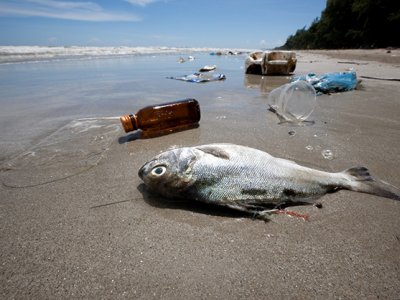 You may have heard about microplastics on the news and on social media, and how they contaminate our seas and oceans, but what are they? Are there any potential health risks associated with them?
You may have heard about microplastics on the news and on social media, and how they contaminate our seas and oceans, but what are they? Are there any potential health risks associated with them?
As global production and use of plastic increases every year a considerable portion of this doesn’t get recycled or safely disposed of but makes its way to rivers, seas and oceans. Here it breaks down into smaller pieces until they are millimetres, micrometres, or even smaller in size. Microplastics present in the environment are eaten by a variety of organisms of all types, from small larvae and planktonic organisms to large marine mammals. This means that these microplastics can enter the food chain and ultimately our bodies. Studies to date show that microplastics not only enter our diet from seafood, such as shellfish, but also from bottled water, sea salt, beer and honey, as well the dust that settles on our dinner.
So, yes, a side of microplastics seems likely with your meal, but one question we have yet to answer is how much, if any harm they actually do. Researchers in the Queensland Alliance for Environmental Health Sciences (QAEHS) are currently working on answering that question.
Authors
 Francisca Ribeiro completed her Master’s Degree in Marine Biology in 2016 and is currently doing her PhD in the field of Environmental Toxicology, with a shared scholarship between UQ and the University of Exeter. She is particularly interested in investigating the risks of the dietary exposure to microplastics through seafood consumption. See below for her presentation in the 2018 Faculty of Health and Behavioural Sciences Three Minute Thesis (3MT®) Competition, entitled 'Is eating seafood becoming a risk?'.
Francisca Ribeiro completed her Master’s Degree in Marine Biology in 2016 and is currently doing her PhD in the field of Environmental Toxicology, with a shared scholarship between UQ and the University of Exeter. She is particularly interested in investigating the risks of the dietary exposure to microplastics through seafood consumption. See below for her presentation in the 2018 Faculty of Health and Behavioural Sciences Three Minute Thesis (3MT®) Competition, entitled 'Is eating seafood becoming a risk?'.
 Professor Kevin Thomas is Director of the (QAEHS). He is an environmental health scientist with a particular interest in understanding the environmental fate, behaviour, effects and risks associated with contaminants of emerging concern (CECs)with the goal of protecting environmental and human health. His current research is focused on assessing community-wide health status through fingerprinting wastewater, establishing alternative approaches to exposure monitoring, for example explanted silicone prostheses and wristbands, understanding human exposure to microplastic particulate pollution and developing analytical methods for characterising CECs.
Professor Kevin Thomas is Director of the (QAEHS). He is an environmental health scientist with a particular interest in understanding the environmental fate, behaviour, effects and risks associated with contaminants of emerging concern (CECs)with the goal of protecting environmental and human health. His current research is focused on assessing community-wide health status through fingerprinting wastewater, establishing alternative approaches to exposure monitoring, for example explanted silicone prostheses and wristbands, understanding human exposure to microplastic particulate pollution and developing analytical methods for characterising CECs.



